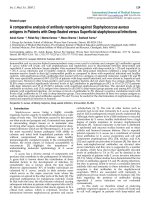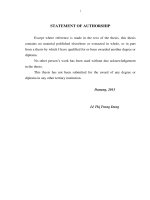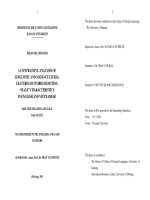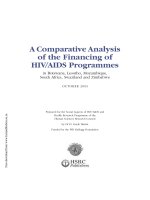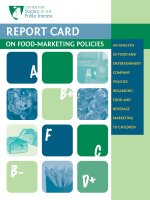A comparative analysis of practitioner and educator preferences regarding accounting curriculum meeting the 150 hour requirement
Bạn đang xem bản rút gọn của tài liệu. Xem và tải ngay bản đầy đủ của tài liệu tại đây (1.65 MB, 154 trang )
A COMPARATIVE ANALYSIS OF PRACTITIONER AND EDUCATOR
PREFERENCES REGARDING ACCOUNTING CURRICULUM MEETING
THE 150-HOUR REQUIREMENT
by
David L. Crawford
Bachelor of Science, South Dakota State University, 1976
Master of Professional Accountancy, University of South Dakota, 1986
A Dissertation
Submitted to the Graduate Faculty
of the
University of North Dakota
in partial fulfillment of the requirements
for the degree of
Doctor of Philosophy
Grand Forks, North Dakota
May
2008
UMI Number: 3324264
INFORMATION TO USERS
The quality of this reproduction is dependent upon the quality of the copy
submitted. Broken or indistinct print, colored or poor quality illustrations and
photographs, print bleed-through, substandard margins, and improper
alignment can adversely affect reproduction.
In the unlikely event that the author did not send a complete manuscript
and there are missing pages, these will be noted. Also, if unauthorized
copyright material had to be removed, a note will indicate the deletion.
®
UMI
UMI Microform 3324264
Copyright 2008 by ProQuest LLC.
All rights reserved. This microform edition is protected against
unauthorized copying under Title 17, United States Code.
ProQuest LLC
789 E. Eisenhower Parkway
PO Box 1346
Ann Arbor, Ml 48106-1346
Copyright 2008 David L. Crawford
11
This dissertation, submitted by David L. Crawford in partial fulfillment of the
requirements for the Degree of Doctor of Philosophy from the University of North
Dakota, has been read by the Faculty Advisory Committee under whom the work has
been done and is hereby approved.
£ ^
x^J~>
Chairperson
&CS^L^>
This dissertation meets the standards for appearance, conforms to the style and
format requirements of the Graduate School of the University of North Dakota, and is
hereby approved.
)G&2.
0
a^2
'•Mat
Deai of the Graduate School
in
PERMISSION
Title
A Comparative Analysis of Practitioner and Educator Preferences
Regarding Accounting Curriculum Meeting the 150-Hour Requirement
Department
Teaching and Learning
Degree
Doctor of Philosophy
In presenting this dissertation in partial fulfillment of the requirements for a
graduate degree from the University of North Dakota, I agree that the library of this
University shall make it freely available for inspection. I further agree that permission for
extensive copying for scholarly purposes may be granted by the professor who supervised
my dissertation work or, in his absence, by the chairperson of the department or the dean
of the Graduate School. It is understood that any copying or publication or other use of
this dissertation or part thereof for financial gain shall not be allowed without my written
permission. It is also understood that due recognition shall be given to me and to the
University of North Dakota in any scholarly use which may be made of any material in
my dissertation.
Signature
Date
3/411>J62
iv
TABLE OF CONTENTS
LIST OF TABLES
ix
ACKNOWLEDGMENTS
xi
ABSTRACT
-.
xii
CHAPTER
I.
II.
INTRODUCTION
1
Theoretical Underpinnings
4
Justification or Rationale
6
Need for the Study
8
Significance of the Study
10
Research Questions
11
Delimitations of the Study
12
Terminology
13
REVIEW OF THE LITERATURE
A Need for Accounting Education
15
15
Apprenticeships
15
Industrial Demand for the CPA
16
Collegiate Education for the CPA
19
Conceptual Framework for Accounting Education
21
1950s-An Emerging Curriculum
21
v
1960s - A Common Body of Knowledge
26
1970s - Educator versus Practitioner Split
29
1980s - The 150-Hour Requirement
35
1990s - The Accounting Education Change Commission 39
The 21st Century Vision
41
Experience Requirements
42
Accounting Models Meeting the 150-Hour Requirement
44
Recent Criticism of Accounting Education
50
Current State of Accounting and the Future of
Accounting Education
52
Chapter Summary
55
METHODOLOGY
59
Purpose of the Study
59
Survey Instrumentation
59
Part I - Time Commitments and Program Structure
61
Part II - Type and Amount of Specialization
61
Part III - Experience Requirements
61
Part IV - Accounting Subjects and Courses
62
Part V - Authority to Prescribe Curriculum
62
Demographic and Background Information
62
Pilot Study
63
Target Population and Data Collection
63
Data Analysis
65
vi
RESULTS
67
Response Rates
67
Data Screening
68
Demographic Data
68
Research Findings
70
Research Question 1
70
Research Question 2
74
Research Question 3
77
Research Question 4
79
Research Question 5
82
Summary
85
SUMMARY, CONCLUSIONS, DISCUSSION, AND
RECOMMENDATIONS
Summary of the Study
86
86
Purpose of the Study
87
Review of the Literature—Brief Summary
87
Methodology—Brief Summary
90
Summary of Questions and Related Findings
91
Conclusions and Discussion
94
Conclusions
94
Discussion
95
Limitations of the Study
107
Recommendations for Further Study
107
vii
Concluding Comments
108
APPENDICES
110
REFERENCES
128
viii
LIST OF TABLES
Table
Page
1.
Response Rates of Practitioner and Educator Groups
68
2.
Demographic Information—Job Title/Rank, Gender, Age, and Education
69
3.
Demographic Information—Years Experience, Specialization, and
Employment Status
71
Demographic Information—Number of Professionals in Firm or
Department, People Supervised/Students Advised
72
5.
Preferences When There is no 150-Hour Requirement
73
6.
Preferences When There is a 150-Hour Requirement
73
7.
Preferences for Type of Specialization Area
75
8.
Preferences as to Time Commitment for Specialization
76
9.
Preferences for Amount of Experience Prior to Licensure
78
10.
Preferences for Type of Experience Prior to Licensure
78
11.
Chi-Square (X2) Values With Degrees of Freedom (df) and
Significance Levels (p) for Research Questions 1-3
79
Means (M), Standard Deviations (SD), F Ratios, and Significance
Levels (p) for Undergraduate Courses
81
Means (M), Standard Deviations (SD), F Ratios, and Significance
Levels (p) for Graduate Courses
83
Means (M), Standard Deviations (SD), F Ratios, and Significance
Levels (p) for Stakeholders
85
4.
12.
13.
14.
15.
Rankings of Undergraduate Courses With Mean (M) Ratings of
4.00 or Higher
ix
102
16.
Rankings of Graduate Courses With Mean (M) Ratings of 4.00 or Higher
x
102
ACKNOWLEDGMENTS
I wish to thank a number of people who have offered their time and support
throughout my educational experience at the University of North Dakota.
I wish to express my gratitude to Dr. David Yearwood, Chairperson of my
Doctoral Committee, who has been steadfast in offering insightful help on matters related
to my educational journey at the University. I offer my thanks to him not only for his
knowledge and patience but also for his forthright and thoughtful opinions as a teacher
and advisor.
I offer my thanks to Dr. Myrna Olson, Dr. Lars Helgeson, Dr. Harold Wilde, and
the late Dr. Jacob Wambsganss, who all played a unique and vital role while serving on
this Committee by making recommendations that invariably improved the quality of this
study. Additionally, I wish to thank Dr. Richard Landry for his expertise and guidance
during the data collection and analysis phase of this undertaking.
Finally, to my wife Trudy, and children Matthew and Rachel, I offer my sincere
appreciation for your support during the past several years. Without your understanding
and cooperation, this achievement would not have been possible.
XI
ABSTRACT
Accounting education has been controversial for several decades because of
diverse interests among stakeholders regarding content, structure, competencies, and
experience needed by entry-level accountants. Elevating debate was the introduction and
adoption of a 150-hour requirement among most of the 55 jurisdictions that regulate
public accounting. Although the 150-hour requirement stipulates the minimum number of
credit hours and a baccalaureate or higher degree, considerable flexibility exists for
accounting programs as to coursework and level of education. Additionally, little
uniformity exists regarding the amount and type of experience required for certification
or licensure. Such diverse conditions, along with widespread implementation of the 150hour requirement, prompted this study to focus on curricular components of content,
program structure, and experiential requirements that are ongoing academic questions in
accounting.
Given the prominent influence on accounting education by practitioners and
educators, this study surveyed both groups in an eleven state Midwest region of the
United States that had adopted the 150-hour requirement. Questions related to curricular
issues in accountancy guided the development of survey questionnaires administered to a
random sample consisting of 1,000 Managing Partners at CPA firms, and concurrently, to
187 Accounting Chairpersons from baccalaureate and higher institutions.
xii
This study found that the 150-hour requirement influences the time commitment
and kind of educational structure preferred by practitioners and educators. The study also
revealed that neither practitioners nor educators support specialization during the formal
educational experience. Majorities from both accounting groups prefer two years of work
experience prior to licensure for entry-level accountants with practitioners clearly
choosing public accounting over other experience. There were significant differences
between practitioners and educators as to appropriate subject/course offerings at both the
undergraduate and graduate level. However, while specific differences were identified at
the undergraduate level of education, findings are more ambiguous at the graduate level.
Finally, both practitioners and educators ranked their own group highest among certain
other stakeholder groups regarding the level of authority to prescribe curriculum.
xiii
To Dr. Larry W. Huus, 1947-2007
CHAPTER I
INTRODUCTION
Formal education of accountants has long been controversial because of diverse
interests among various stakeholders. In addition to the question of how much education
is sufficient, the structure, coursework, topics, and competencies comprising the
curriculum have not been firmly established or uniformly accepted. Curriculum as
defined by Stark and Lattuca (1997) is "an academic plan promoting purposeful learning
of knowledge, skills, and attitudes, in addition to content, sequence, instructional
processes, evaluation, and adjustments for improvement" (pp. 325-330). Eisner (1979)
expands this further by indicating that there are really three curricula: the explicit, the
implicit and the null curricula. The explicit curriculum includes the content, structure and
learning objectives of the discipline and is usually stated in writing. The implicit
curriculum is more nebulous and may include skills, competencies, social, and cultural
values that are usually unwritten yet imparted to the student through disciplinary study or
related experience. The null curriculum might stem from a conscious and political
decision about what not to teach at all (de Lacey, n.d.). Therefore, while curriculum is
considered a cohesive framework that integrates many features of teaching and learning,
one aspect of that structure advanced by McNeil (2006) includes content found in course
offerings. This particular concept of the curriculum can be viewed as a subset of courses
representing how a discipline will organize core and supporting program requirements.
1
Curriculum as a concept originated with the creation of formal schooling
(McNeil, 2003) and continues to drive the structure of modern academic programs in
higher education such as accountancy. The ongoing quest for an appropriate explicit
structural framework in accounting curriculum has elicited as much if not more debate
than implicit themes related to competencies, skills, and behaviors desirable in
accounting graduates (American Institute of Certified Public Accountants, n.d.). While
the popularity of implicit curriculum topics signaled a shift away from knowledge-based
course content and focused attention on what Boschee & Baron (1993) describe as
outcome-based education, the more explicit curricular issues of content and program
structure have not been clearly addressed by accounting educators or practitioners.
Recently, this lack of clarity, together with more varied and unique program structures,
prompted a proposal to prescribe specific curriculum content by the National Association
of State Boards of Accountancy (2005).
Education for individuals entering accountancy has traditionally consisted of a
four-year baccalaureate degree. However, for many years there have been ongoing
discussions within the profession regarding the need for additional education beyond the
four-year degree, which culminated in most states requiring at least five years of study in
order to take the Uniform Certified Public Accountant (CPA) examination. Interestingly,
the issue of post-baccalaureate education for accountants has been a policy formally
embraced by the predominant national practitioner group, the American Institute of
Certified Public Accountants (AICPA) since 1959 (Van Wyhe, 1994). In 1988, nearly
thirty years after the 1959 acknowledgement, general membership of the AICPA voted
requiring all new members to have 150 semester hours of college education including a
2
minimum of a baccalaureate degree (American Institute of Certified Public Accountants,
n.d.). Although this requirement did not take effect until after the year 2000, ostensibly,
such a mandate should have ended much of the educational controversy. However, many
stakeholders remain unconvinced as to the value of the 150-hour requirement (Albrecht
& Sack, 2000) and are uncertain about what course content should be included in the
additional year of study.
There are essentially two stakeholder groups most influential in curriculum
development and reform (Flaherty, 1979; Novin, Fetyo & Tucker, 1997; Rumble, 1998):
public accounting practitioners and accounting educators. Therefore, regardless of how
one views the curriculum, it is clear that educators and practitioners play a vital role in
shaping, defining, and implementing the curriculum—the stated (explicit), implied and
null curriculum. The fact that the stated curriculum includes a sequence of courses
(American Accounting Association, 1954; American Accounting Association, 1956;
American Institute of Certified Public Accountants, 1988; Needles & Powers, 1990) with
a specific number of course credits (American Institute of Certified Public Accountants,
1988; Commission on Professional Accounting Education, 1983; Covaleski, 2000;
Heffernan, 1973; Russel & Smith, 2003) suggests that both educators and practitioners
can and should be able to arrive at some common understanding about what constitutes a
core of course work within an accounting program of study. The dynamic nature of
curriculum suggests a need for scholarship that examines preferred course content at the
undergraduate and the post-baccalaureate graduate level while considering the 150-hour
requirement that pervades the current status of accounting education.
3
Theoretical Underpinnings
Sterling (1973) asserts that harmony exists between education and practice in
accounting due to educators' inclination to prepare students for employment. This
mutually beneficial relationship is based largely on the notion that while practitioners
may, over time, add to accepted practice, "the educator must observe, codify and teach
these additional accepted practices" (p. 169). This form of education aligns with the
pragmatist philosophy which recognizes that shared human experiences can result in
ideas for solving problems and ultimately asks whether an idea works (Gutek, 2004).
However, to merely exclaim that accounting is based upon what works is also an over
simplification of what practice really is, for unless practice can stand up to theoretical
scrutiny, it is bound to fail. Justifiably, practice must be subjected to rigorous critical
inquiry that is largely the responsibility of the academic community via related research.
An additional consideration oft debated among accounting professionals is the
need for relevant experience following formal education (American Accounting
Association, 1972; American Institute of Certified Public Accountants, 1969;
Graves, 2004; Perry, 1955). While it may seem obvious that experience is desirable for
the professional development of an accountant, the required amount and type of
experience has never been clear or uniformly accepted. Early in the 20th century, partly
due to the limited educational requirements that could be imposed at the time, accounting
practitioners concluded that no single criteria was sufficient to assure competence and
thus formal education followed by success on the Uniform CPA examination and a
relevant experience requirement became the accepted practice.
4
This combination of requirements is in accord with the pragmatic thinking of
many educators influenced by John Dewey at the time (Previts & Merino, 1998). While
some misinterpreted Dewey's brand of progressive education to mean narrow vocational
skills, Dewey really advocated experience that builds on previous education as the
connectedness that promotes growth of the individual (Dewey, 1938). Dewey's idea of
systematically solving problems coincides with how most accountants view their work
role and appears to be a major force driving the framework of accounting education to
this day. Tanner and Tanner (1995) point out that what Dewey referred to as the scientific
method was a form of systematic inquiry that he often alluded to as reflective thinking
free from rigid or sequential constraints. According to Dewey (1916), meaningful
experience requires an element of thought or reflection and is far superior to mere trial
and error. Such experience expands one's conceptual framework and promotes the
application of learning to a multitude of situations that vary from the initial experience
(Dewey).
Essentially, linking scholarly activity with practical experience that builds on
formal learning has permeated professional accounting education for decades and has
been a pragmatic conduit for imparting theory into practice. In essence, experience
coupled with life-long learning has become part of the implicit accounting curriculum.
A speech by Hensler (1990) to an accounting symposium regarding the
background and recommendations for accounting education included: "The common
thread that weaves through twenty years of commissions and committee reports is the
need to hire and retain professional accountants with broad liberal-arts backgrounds..."
(p. 63). Indeed, this theme appears in the literature almost from the beginning of
5
discussions concerning accounting as a profession (Previts & Merino, 1998) and has
continued to carry forward to the present. Early authors on accounting education such as
Kester (1936) and Carey (1937) stressed the need for a liberal education followed by
specialized training in accounting as the ideal education for accountants. Later studies
adhered to this concept and established a general model with liberal education consisting
of approximately 50% of the coursework and an equal split between business and
accounting courses for the other 50% (American Accounting Association, 1954). This
concept of a broad based education is significant because it purports to distinguish
accountancy from a technical trade, thus influencing the structural makeup of accounting
programs. In addition, a liberal-arts background is complicit with other disciplines
worthy of collegiate level study and presents evidence supporting the conceptual nature
of knowledge in the field.
Given the 150-hour mandate that most states are now required to follow, the issue
of educational breadth versus specialization becomes more urgent. While four-year
accounting programs have generally provided little if any option for specialized studies
within the curriculum, the concept of using the additional credit hours for more focused
and in-depth study in accounting is worthy of consideration.
Justification or Rationale
The actual certification and licensing of public accountants takes place at the state
level. The AICPA mandate for membership prompted most state regulatory jurisdictions
to pass legislation requiring 150-hours of education for those taking the CPA exam. In
response to this requirement, colleges and universities with accounting programs
attempted to address the issue through appropriate changes but have not done so
6
uniformly. Essentially, there is a fair amount of flexibility as to how institutions of higher
education may choose to deal with the 150-hour issue (Williams, 1990). Some accounting
programs treated the extra 30 hours as undergraduate credits while others have opted for
graduate credits. Currently, many accounting programs (Covaleski, 2001; Ethridge &
Hemmingway, 1993) continue to offer the traditional baccalaureate degree of
approximately 120 hours and recommend that students consider additional study in a
second major as fulfilling credit requirements. Others (Donelan & Reed, 2000;
Rumble, 1998; Shafer & Kunkel, 2001) have implemented 150-hour baccalaureate
programs or have modified and created masters level graduate programs that provide for
both the bachelor's and master's degrees in accounting. While flexibility that affords
differences in accounting programs has merit, the resulting unique programmatic and
curriculum variations have created additional controversy among stakeholders and
licensing j urisdictions.
Many accounting educators have been unsupportive of the 150-hour requirement
while questioning the necessity and cost of advanced and graduate education for entry
level accountants (Albrecht & Sack, 2000; Anderson & Griffin, 1963) and have often
advocated for a well planned and reasonably rigorous four-year program to educate entry
level professionals (Mautz, 1974). Practitioners have generally been supportive of
additional education requirements whereas accounting educators have often been opposed
to the practice point of view concerning the amount, type, and level of education that is
best suited for accountants (Colson, 2002; Kerrigan, 1959; Miller & Bahnson, 2003;
Rimmerman & Daroca, 1990). Academics have historically viewed accounting education
from a broader disciplinary perspective that favors a balanced approach in financial and
7
managerial topics whereas public accounting deals primarily with financial and audit
services that elicit different emphases in a curriculum. Regarding curricular content and
structure, it is unclear as to where practitioners or educators stand in relation to each other
given the mandated changes for increased education meeting the 150-hour requirement.
Need for the Study
For decades, there have been calls for more research related to the structure of
accounting programs (Rebele, 2002). Referring to the common body of knowledge
disseminated in the 1967 Horizons study, Mautz (1974) stated: "we have not yet had the
kind of consideration that is needed to determine how that common body of knowledge
might best be put together in an educational program" (p. 359). Williams, Tiller, Herring
& Scheiner (1988) noted that work concerning the structure of accounting curriculum
remains to be done and that "a related question of how the dual characteristics of
accounting programs—professional education at the undergraduate and master's
levels...is related to academic structure" (p. 136). An indication that these questions have
yet to be answered can be confirmed by considering the recent American Accounting
Association (2006) call for a study to examine the common body of knowledge at both
the undergraduate and graduate levels, or from Allen and Woodland (2006) who indicate
that an issue still remaining is "what academic content should be required in the 150
hours?" (p. 174). Should the additional education be geared towards specialization, or
should it increase the breadth of the education? Together, these questions are central to
the curriculum and elicit a pressing need for additional research into the form, content,
and structure of accounting programs.
8
Closely related to the time commitment, content, and make-up of formal
education is the matter of amount and type of experience needed for the practice of public
accountancy prior to licensure. Experience and formal education are issues not easily
divorced if reasons for the requirements—protection of the public from incompetent
practitioners—is to be considered. Indeed, it was this notion of complementing what
formal education could not do (Merino, 1977) that prompted licensing jurisdictions to
mandate experience. Over the years, this requirement has been debated (Commission on
Standards of Education and Experience, 1956) and jurisdictions, while generally
requiring some form of experience, are by no means uniform (American Institute of
Certified Public Accountants and National Association of State Boards of Accountancy,
2000). Consequently, there is a need for more information regarding accounting
curriculum as it relates to the preferred amount and type of experience necessary prior to
licensure.
Recent action by the National Association of State Boards of Accountancy
(NASBA) in an attempt at prescribing curriculum content is an indication that curricular
choices are in need of attention by interested stakeholders involved in the educational
process. There appears to be a need for information that helps explain what is wrong in
accounting education and how to go about improving it. Systematic research in the area
of accounting education should help to answer critical questions by providing data that
will guide future policy making in the area (Reckers, 2006). Absent such research,
concerned stakeholders (i.e., practitioners, educators, and others) will continue to be at
odds with politically motivated special interest whims having little concern regarding the
appropriate academic preparation of CPAs.
9
A considerable amount has been written about the 150-hour requirement but there
is little comparative analysis of practitioner and educator preferences since actual
adoption and implementation of the mandate. This shortage of information has
contributed to a lack of clarity with respect to preferred program structure, the amount of
specialization, and the level at which specific accounting coursework should be offered.
Consequently, a fundamental question posed by Tyler (1950) regarding effective
organization of educational experiences is in need of attention.
Both the educator and public practitioner groups are, and should be, instrumental
in the formulation of accounting curriculum. While the educator is often considered an
expert on curriculum issues, there appears to be support for new paradigms to begin at the
grassroots level. Tanner and Tanner (1995) note: "Paradigms are not concocted out of
hat, but from the world of practice" (p. 229). Apparently, there is sufficient precedent to
include both the practitioner and educator as legitimate contributors when it comes to
curricular change.
Significance of the Study
Controversy over the 150-hour requirement continues. While it is unlikely the
requirement will be reversed, there is a need to increase the knowledge base in
accounting education and lend focus to potential changes in curricular components that
constitute accounting programs of study. Williams, et al. (1988) noted a trend toward
longer education requirements for accounting students before entering practice and
observed: "work on the content and alternative structures for five-year programs will
contribute to knowledge of accounting education in general and will be of great value to
those schools that have not yet made the transition" (p. 136). This comment seems even
10
